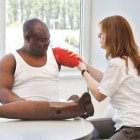Rehabilitation
Prosthetic fitting
The prosthetic fitting
You will be fitted with your new prosthesis once your residual limb has healed and has stabilized in its size. This usually takes from four to six weeks after the surgery.
During your first fitting visit with your prosthetic team, they will make a cast of your residual limb with plaster so that they have an exact replica of your limb. This will be used to make a test socket. The test socket is an interim socket that allows your team to customize the fit of your prosthesis and is generally made from a clear thermoplastic. The material is easily reformed to get an intimate fit, and, because it is transparent, shows where your skin is coming in contact with the socket.
Socket fit is very important. Think of it as a shoe: if it doesn’t fit well, you can’t walk well—no matter how many socks you wear. Once the socket as been customized for your unique anatomy, a definitive socket will be fabricated from lightweight thermoplastic or carbon fiber. The prosthetic components are then attached to this socket.
Training to use your prosthesis
The goal of rehabilitation training with a physical therapist is to help you gain as much mobility and independence as possible.
Your therapist will help you learn how to use and care for your prosthesis properly, including how to put the prosthesis on and taking it off. Then you’ll begin controls training, repetitive drills, and finally, Activities of Daily Living (ADLs).
Handling

Putting on and taking off your prosthesis
Correctly putting your prosthesis on (donning) and taking it off (doffing) by yourself is an important everyday task. Your family or friends may need to help you initially, but the goal is for you to ultimately be able to do this on your own.
There are different ways to put on your prosthesis depending on the type of prosthesis you have and the condition of your residual limb. Your therapist will show you which ones are suitable for you.

Caring for your prosthesis
Wipe the inside of the socket with a moist cloth to remove sweat residue and skin particles.
Keeping the contact surface with the skin clean helps to avoid skin irritation. If you wear a liner, please care for it daily according to the user manual.
Finally, if you have a myoelectric system, you’ll likely have to charge the batteries daily.
Activities of daily living

Controls Training
Depending on the components used in your prosthesis, controls training will teach you how to open and close your terminal device or hand, rotate it internally and externally, and, in case of higher level amputations, how to flex or extend the elbow and shoulder. Think of controls training as learning about all the controls for driving a car—without really driving yet.
Also note that putting the prosthesis on in the morning right after you wash is often more difficult than usual, since warm water causes the skin on the residual limb to swell.

Repetitive Drills
Repetitive drills is where you begin to practice ‘driving the car’. You’ll practice making specific movement patterns. The more you practice the better you’ll get at remaining relaxed while performing the movements, and the more automated the movements will become. With enough repetition, you’ll be able to simply make a movement, instead of thinking about it.
Suitable exercise accessories include cones, various peg board games or a pinch tree with individual pegs, which are changed in their vertical or horizontal positions. This means you have to purposefully rotate and grip with your prosthetic hand.

Activities of Daily Living (ADLs) and Everyday Training
After the repetitive drills, you’ll be ready for more complex movements that you’ll encounter in everyday life. Your therapist may tailor this training you your personal goals and needs, depending on your day-to-day life and occupation.
You may begin with simpler activities such as folding a towel, and then work your way up to things such as preparing a complete meal and eating it with a knife and fork. ADL training may also include getting dressed and undressed; opening a bottle and pouring a drink; and using a computer and office tools.
Additional therapeutic measures

Assistive Device Consulting
If you experience difficulties with your new prosthesis while performing certain activities, various assistive devices may be used to increase your independence. Your therapist can determine whether this is an option for you.
However, the less is more rule applies to all devices; the fewer devices you need, the greater your day-to-day independence. If you use many specialized devices in your home environment, it will be more difficult to function outside the home without those devices.

Leisure and Sports
It is also important to be physically fit, and your prosthesis will help you participate in more sports and leisure activities. Talk to your therapist about strategies for getting the most out of your prosthesis.



